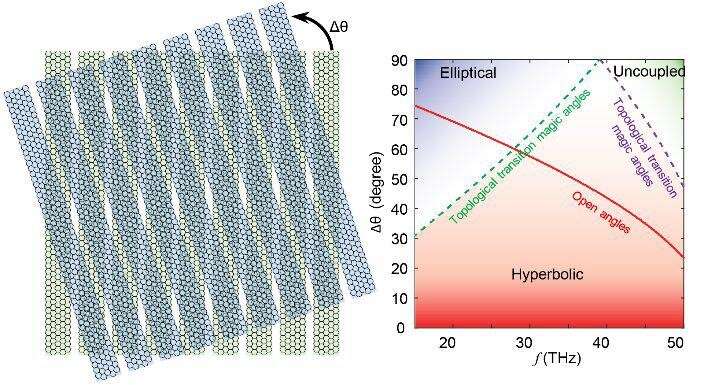Moire lattices of photonic metasurfaces made of graphene nanoribbons also have a twist in the tale. Credit: ACS Nano Letters
Quantum optics, spintronics and diffraction-free imaging with low loss are among the technologies that may benefit from recently predicted effects in twisted bilayer photonic structures. The work takes inspiration from a burgeoning field of condensed matter research—"twistronics," in which electronic behaviour can be dramatically altered by controlling the twist between layers of 2-D materials.
When Pablo Jarillo-Herrero and his group announced observations of electronic properties tuned between superconducting and Mott insulating states there was excitement not just among those researchers working closely with graphene and 2-D materials but many other fields. Naturally, not all research communities expected to find associated phenomena in the systems they studied.
"There was no reason to think this would happen in photonics—the effects stem from correlated electrons and we instead work with photons," explains Andrea Alù, Einstein Professor at City University of New York (CUNY). Nonetheless in a recent Nano Letters paper, he and colleagues at CUNY, the National University of Singapore, and the University of Texas at Austin have reported theoretical predictions of photonic behaviour changes with twisting that is in many ways analogous to the changes in electronic behaviour first observed in bilayer graphene.
Flatbands
As you twist one periodic grid with respect to another on top, new "Moiré" patterns emerge that can make your eyes feel dizzy. Similarly, twisting one layer of honeycomb-shaped graphene atomic lattice with respect to another produces a Moiré superlattice with twist-dependent properties. The periodic potential fields change with dramatic effects on how electrons move, which affects how the energy levels or bands available change with the electron's momentum. At a "magic angle" of 1.1°—excruciatingly awkward to achieve in experiments—the slope flattens entirely, a stark contrast to the steep change in energy with momentum found in single layer graphene. It was on hearing about these "flat bands" that Alù's ears pricked up because they had noticed photonic flat bands in the metasurface systems they were studying.
In metamaterials, the material's composition and structure can give it optical properties that would not be found in nature, such as negative refractive indices or an extremely asymmetric "hyperbolic" optical response. In general, light emanating from a point source ripples outward in rings like waves from a pebble dropped in a pond. But in a metamaterial engineered so that the optical response in one direction is different to the perpendicular direction the rings become elliptical.
Take that asymmetry to an extreme, and the waves no longer form closed rings at all, but take off along a hyperbola like a rocket at escape velocity. The effect can be tantalising in metamaterials, which tend to be very lossy, so little light gets very far anyway. Metasurfaces, however, give the same effect, but at the surface, where you can really start to exploit the enhanced light-matter interactions from these hyperbolic optical responses.
Cutting graphene into long strips also affects how it behaves, and in 2015, Alù and his group showed that graphene nanoribbons could behave as a kind of metasurface. Light shone on a graphene nanoribbon sends large numbers of electrons oscillating in unison in response to the incident electromagnetic field—"a plasmon." More interesting still in a periodic grill of graphene nanoribbons these plasmons are hyperbolic.
"The reason why the flatband in twisted bilayer graphene resonated with us is if you take a graphene nanoribbon surface, there is a broad range of frequencies that give a hyperbolic propagation but at a point it becomes elliptical—there is a flat band for light," says Alù.
The photonic flatband means that the light travels without diffraction and light matter interactions are maximized. The catch is that the material is also at resonance at this point, meaning its loss is at a maximum. Hearing about the flatband in twisted bilayer graphene Alù and colleagues wondered whether stacking two graphene nanoribbon metasurfaces might provide some twist control over these photonic flatbands.
Twisted photonics
Alù and his colleagues studied the Green's function of the bilayer graphene nanoribbon grills to evaluate the optical behaviour. They found that the two layers couple giving one plasmon mode with two energies for the whole bilayer system. In addition, the frequency of the flatband shifts so that maximum light matter interactions are possible when the materials is not at resonance. Finally, the transitions for their systems occur around 45° - much larger and more experimentally accessible than the magic angle in graphene bilayer systems, reflecting the larger periodicity of the nanoribbon grill. Since the angle is frequency dependent it is possible to sweep through frequencies to find the exact sweet point of the system.
In fact "canalization"—the diffraction-free propagation of light that occurs at the flatband point—has already been observed in a beam sent through two optical lattices of light at specific twist angles. The metasurfaces described by Alù and colleagues provide a further photonics system for exploring twist effects that may be easier to produce than magic angle bilayer graphene, as well as highlighting some new physics. "To me, the most exciting part is the beauty of how you can predict this from purely geometric formulae," says Alù.
In addition, the photonic flatband effects may prove useful for applications—quantum optics and imaging in particular. "People are often asking—how do we enhance the interaction of confined light emitters with matter, and how do we route the enhanced emission without diffraction?" says Alù. "This is an ideal platform—it's broadband and you can tune the frequency."
More information: Guangwei Hu et al. Moiré Hyperbolic Metasurfaces. Nano Letters (2020) Accepted manuscript pubs.acs.org/doi/10.1021/acs.nanolett.9b05319
Journal information: Nano Letters
© 2020 Science X Network
























